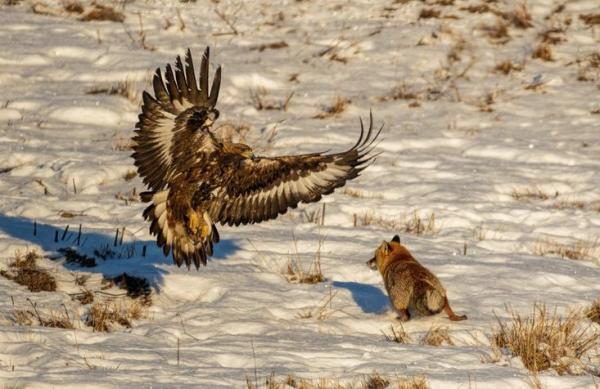
The term birds of prey refers to all birds that actively hunt and feed on other vertebrates. They are characterized by certain physical features such as hook-tipped beaks and sharp, curved talons, as well as a keen eye for spotting prey. There are many species of birds in this group, but eagles are one of the most representative. Since Babylonian times, eagles have symbolized war and imperial power because of their strength.
In this AnimalWised article you will learn how eagles hunt, the different techniques they use, what they eat and some of their most important characteristics.
Characteristics of eagles
Eagle is the common name for many large birds of prey in the family Accipitridae. Eagles belong to several groups of genera, and currently there are a total of 68 species of eagles. Eagles are widespread, but most species are native to Eurasia and Africa. Let us take a closer look at some main characteristics of eagles:
- Some species of eagles are among the largest birds of prey in the world. The wedge-tailed eagle (Aquila audax), for example, has a wingspan of 2.84 m (9.32 ft) and is native to Australia. The golden eagle (Aquila chrysaetos), on the other hand, is common in Europe, North America and Asia and has a maximum wingspan of 2.34 m (7.68 ft).
- The size of eagles varies greatly depending on the species. The smallest species, such as the booted eagle (Hieraaetus pennatus), reach weights of 770 g (1.70 lb.). The Steller's sea eagle (Haliaeetus pelagicus), on the other hand, can weigh up to 9,500 g (20.9 lb.). Females are generally larger than males.
- The coloration of their wings varies from one species to another, but typically they tend to be dark brown and black, with some white, gold, or yellow.
- Like all birds of prey, eagles have robust, strong and pointed beaks, ideal for tearing their prey. They also have strong, muscular legs, and powerful talons.
- The eyes of eagles are extremely powerful, and it is estimated that some species have visual acuity up to 8 times that of humans. This allows eagles to detect potential prey at great distances.
- Their habitats are diverse and vary by species. They are found in lush forests, arid areas, alluvial plains, swamps, mountainous regions, semideserts, wooded savannas, and even urban areas.
- There are four major groups of eagles: osprey, booted eagle, serpent eagle and giant forest eagle.
- Eagles are monogamous. They mate for life and use the same nest every year. They usually nest in inaccessible places and incubate a small clutch of eggs for six to eight weeks.
You can learn more about eagles and their main characteristics in this other article, where we discuss the different types of eagles that exist.
What do eagles eat?
Eagles are carnivores with a very varied diet, which depends on the ecosystem they are in and the animals that live there. In general, however, we can say that their diet consists mainly of mammals and birds, which they consume both alive and as carrion. Some of the animals eagles feed on include:
- Mammals: raccoons, rodents, hedgehogs, squirrels, prairie dogs, guinea pigs, rabbits, hamsters, gerbils, sugar gliders etc.
- Reptiles: snakes, frogs, salamanders, lizards, and chameleons.
- Birds: ducks, owls, baby birds, screamers, doves, sparrows, songbirds, quail, finches, pigeons, crows, ravens, chickens, macaws, etc.
- Large species: young deer, monkeys, sloths, bats, civets, flying squirrels, and macaques.
The diet of eagles living near the coast includes seabirds and sometimes fish (only if they are visible on the surface).
In addition to catching live prey, eagles rely on carrion from fish, birds, and mammals, especially in winter.
Many species of eagles are also opportunistic hunters, which means that they can also steal the prey of other birds.
You can learn more about other birds that feed on other animals by reading this other article about carnivorous birds.

How do eagles hunt?
Unlike other birds that feed on seeds or insects and travel only short distances in search of a meal, the eagle must often travel great distances to find worthy food. To do this without expending the excessive amounts of energy that flapping flight would require, the eagle has become a master of soaring flight. Riding vertical, spiraling columns of warm air, called thermals, the eagle can travel up to twenty miles per hour with virtually no effort.
A striking feature of these birds of prey is their stocky build and their ability to lift animals that are somewhat heavier than themselves. In cases where the prey is too heavy to carry to the nest, several eagles can dismember it with their talons and carry it up in pieces.
All eagles are fearsomely skilled in the art of silently attacking, sneaking up on, and snatching their victims. Eagles may employ various strategies when hunting their prey, depending primarily on their location and the size of their prey. Some of them include:
- Hunting in flight: once the eagle has spotted its prey, it follows it unobtrusively to avoid detection. When it is close, it extends its powerful talons and catches it, usually killing it on the spot by the pressure exerted by its feet. In the dive, the eagle glides and flies very fast, with an average speed of about 50 km per hour.
- Hunting close to the ground: to catch a larger animal, however, they are able to fly close to the ground, chasing its prey and, when the time is right, they attack, holding on to the victim with their powerful claws.
- Hunting from a high place: eagles also hide in a high place, such as a tree, to locate possible prey without having to be in the air. As soon as the prey approaches, they swoop down on it in seconds.
Hunting seems to be an innate behavior and ability in eagles, which means that their behavior is closely controlled by their genes, which run naturally without learning or practice. And once the eaglets are 8 to 12 weeks old, they fly away from their nest and live on their own.
Most of the time, eagles are seen hunting alone. However, in some cases, especially before mating, eagles may hunt in pairs. Together, they may manage to take down a large prey such as deer, antelope, etc.
When and how often do eagles hunt?
Eagles are considered diurnal birds of prey, which means that they hunt during the day. Eagles cannot see clearly in the dark, so they avoid hunting at night. They are also active at dawn and dusk.
Eagles do not hunt every day because they can catch large prey and feed on it for several days. On average, an eagle can eat about 8% to 12% of its body weight per day.
If you want to read similar articles to How Do Eagles Hunt? - Eagle Hunting Habits, we recommend you visit our Facts about the animal kingdom category.
- Bird Life International. (2021). Aquila species . Available at: http://datazone.birdlife.org/quicksearch?qs=Aquila.
- Margalida, A., Colomer, M., Sánchez, R., Sánchez, F., Oria, J., González, LM. (2017). Behavioral evidence of hunting and foraging techniques by a top predator suggests the importance of foraging for pre-adults . Ecology and Evolution, 7 (12), 4192-4199. Available at: https://doi.org/10.1002/ece3.2944
- Wagner, E. (2017). The golden, deadly and devious eagle . Smithsonian Magazine. Available at: https://www.smithsonianmag.com/science-nature/royal-raptor-180949437/